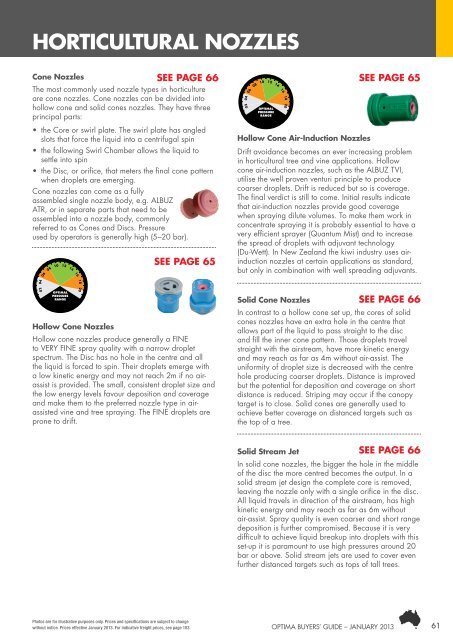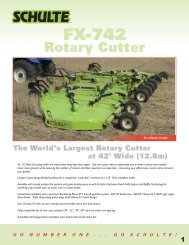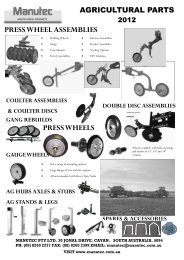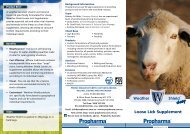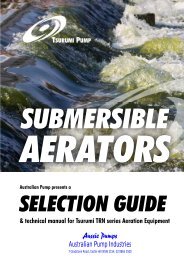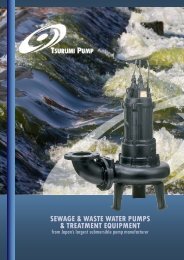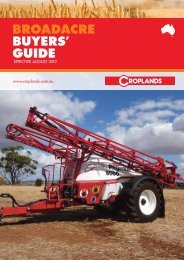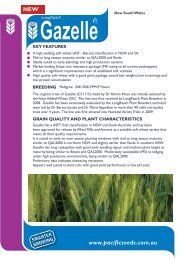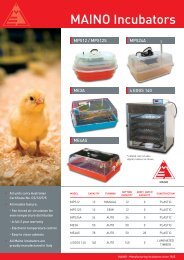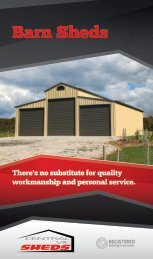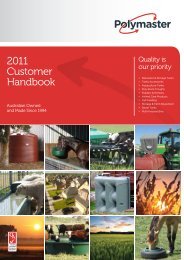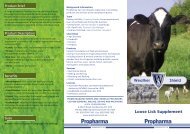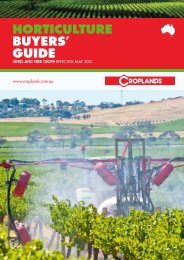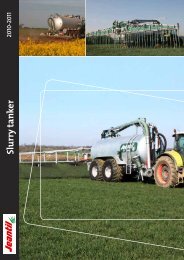Linkage Sprayers Product Information (13176 Kb) - Fatcow
Linkage Sprayers Product Information (13176 Kb) - Fatcow
Linkage Sprayers Product Information (13176 Kb) - Fatcow
Create successful ePaper yourself
Turn your PDF publications into a flip-book with our unique Google optimized e-Paper software.
hollow cone<br />
air induction<br />
hollow cone<br />
air induction<br />
HORTICULTURAL NOZZLES<br />
Cone Nozzles<br />
The most commonly used nozzle types in horticulture<br />
are cone nozzles. Cone nozzles can be divided into<br />
hollow cone and solid cones nozzles. They have three OPTIMAL<br />
PRESSURE<br />
RANGE<br />
principal parts:<br />
• the Core or swirl plate. The swirl plate has angled<br />
slots that force the liquid into a centrifugal spin<br />
• the following Swirl Chamber allows the liquid to<br />
settle into spin<br />
• the Disc, or orifice, that meters the final cone pattern<br />
when droplets are emerging.<br />
Cone nozzles can come as a fully<br />
assembled single nozzle body, e.g. ALBUZ<br />
ATR, or in separate parts that need to be<br />
assembled into a nozzle body, commonly<br />
referred to as Cones and Discs. Pressure<br />
used by operators is generally high (5–20 bar).<br />
06<br />
08<br />
10<br />
12<br />
14<br />
16<br />
06<br />
08<br />
10<br />
12<br />
14<br />
16<br />
See page 66<br />
04<br />
02<br />
06<br />
08<br />
10<br />
12<br />
See page 65<br />
14<br />
16<br />
18<br />
20<br />
04<br />
02<br />
06<br />
08<br />
10<br />
12<br />
OPTIMAL<br />
PRESSURE<br />
RANGE<br />
14<br />
16<br />
18<br />
20<br />
See page 65<br />
Hollow Cone Air-Induction Nozzles<br />
Drift avoidance becomes an ever increasing problem<br />
in horticultural tree and vine applications. Hollow<br />
cone air-induction nozzles, such as the ALBUZ TVI,<br />
utilise the well proven venturi principle to produce<br />
coarser droplets. Drift is reduced but so is coverage.<br />
The final verdict is still to come. Initial results indicate<br />
that air-induction nozzles provide good coverage<br />
when spraying dilute volumes. To make them work in<br />
concentrate spraying it is probably essential to have a<br />
very efficient sprayer (Quantum Mist) and to increase<br />
the spread of droplets with adjuvant technology<br />
(Du-Wett). In New Zealand the kiwi industry uses airinduction<br />
nozzles at certain applications as standard,<br />
but only in combination with well spreading adjuvants.<br />
04<br />
04<br />
18<br />
18<br />
02<br />
OPTIMAL<br />
PRESSURE<br />
RANGE<br />
20<br />
02<br />
OPTIMAL<br />
PRESSURE<br />
RANGE<br />
Hollow Cone Nozzles<br />
Hollow cone nozzles produce generally a FINE<br />
to VERY FINE spray quality with a narrow droplet<br />
spectrum. The Disc has no hole in the centre and all<br />
the liquid is forced to spin. Their droplets emerge with<br />
a low kinetic energy and may not reach 2m if no airassist<br />
is provided. The small, consistent droplet size and<br />
the low energy levels favour deposition and coverage<br />
and make them to the preferred nozzle type in airassisted<br />
vine and tree spraying. The FINE droplets are<br />
prone to drift.<br />
20<br />
See page 66<br />
Solid Cone Nozzles<br />
In contrast to a hollow cone set up, the cores of solid<br />
cones nozzles have an extra hole in the centre that<br />
allows part of the liquid to pass straight to the disc<br />
and fill the inner cone pattern. Those droplets travel<br />
straight with the airstream, have more kinetic energy<br />
and may reach as far as 4m without air-assist. The<br />
uniformity of droplet size is decreased with the centre<br />
hole producing coarser droplets. Distance is improved<br />
but the potential for deposition and coverage on short<br />
distance is reduced. Striping may occur if the canopy<br />
target is to close. Solid cones are generally used to<br />
achieve better coverage on distanced targets such as<br />
the top of a tree.<br />
See page 66<br />
Solid Stream Jet<br />
In solid cone nozzles, the bigger the hole in the middle<br />
of the disc the more centred becomes the output. In a<br />
solid stream jet design the complete core is removed,<br />
leaving the nozzle only with a single orifice in the disc.<br />
All liquid travels in direction of the airstream, has high<br />
kinetic energy and may reach as far as 6m without<br />
air-assist. Spray quality is even coarser and short range<br />
deposition is further compromised. Because it is very<br />
difficult to achieve liquid breakup into droplets with this<br />
set-up it is paramount to use high pressures around 20<br />
bar or above. Solid stream jets are used to cover even<br />
further distanced targets such as tops of tall trees.<br />
Photos are for illustrative purposes only. Prices and specifications are subject to change<br />
without notice. Prices effective January 2013. For indicative freight prices, see page 103. 61<br />
Optima BUYERS’ GUIDE – JANUARY 2013


